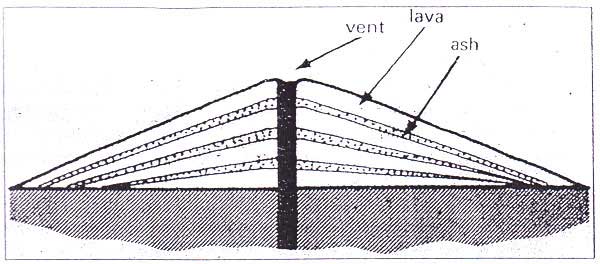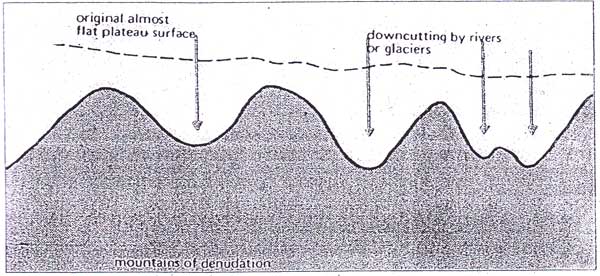(World Geography) - Mountains, Plateaus and Plains & Compressional Tectonic Forces
WORLD GEOGRAPHY
Concepts of Geography, Natural Resources
MOUNTAINS, PLATEAUS AND PLAINS
In general, geomorphic processes that originate within Earth, called endogenic processes result in an increase in surface relief, which the exogenic processes, those that originate at Earth’s surface, tend to decrease relief. Igneous and tectonic processes constitute the endogenic geomorphic processes. Exogenic processes consist of various means of rock breakdown, collectively known as weathering, and the removal, movement, and relocation of those weathered rock products in the continuum of processes known as erosion, transportation, and deposition. These processes decide the landforms on earth.
COMPRESSIONAL TECTONIC FORCES
Folding, which is a bending or rock layers, occurs when compressional forces are applied to rocks that are ductile (bendable), as opposed to brittle. Rocks that lie deep within the crust and are therefore under high pressure are generally ductile and particularly susceptible to behaving plastically, that is, deforming without breaking. As a result rocks deep within the crust typically fold rather than break in response to compressional forces. As elements of rocks structure, upfolds are called anticlines, and downfolds are called synclines. The rock layers that form the flanks of anticlinal crests and synclinal trough are the fold limbs.
Faulting is the slippage or displacement of rocks
along a fracture surface, and the fracture surface along which movement
has occurred is fault. When compressional forces cause faulting either
one mass of is pushed up along a steep.
Angled fault relative to the other or one mass of rock slides along a
shallow low-angle fault over the other the other. The steep, high-fault
resulting from compressional forces is termed a reverse fault. Where
compression pushes rocks along a low angle fault so that they override
rocks on the other side of the fault, the fracture surface is called a
thrust fault, and the shallow displacement is an overthrust.
In both, reverse and thrust faults, one blocks of crustal rocks is wedged up relative to the other. Reverse or thrust faulting can also result form compressional forces that are applied rapidly and in some cases to rocks that have already responded to the force by folding in the latter case, the upper part of a fold breaks, sliding over the lower rock layers along a thrust fault forming an overthrust. Together, recumbent folds and overthrusts are important rock structures that have formed in complex mountain ranges such as the Andes, Alps, Himalayas.
MOUNTAINS
Types of Mountains: Based on their mode of formation, four main types of mountains can be distinguished.
1. Fold mountains: They are caused by large-scale earth movements, when stresses are set up in the earth’s crust. When such stresses are initiated, the rockes are subjected to compressive forces produce wrinkling or folding along the lines of weakness. The unfolded waves are called anticlines and the troughs or down folds are synclines. Due to the complexity of the compression forces, the folds developed much complicated forms. When the crest of a fold is pushed too far, an overfold is formed. If it is pushed still further, it becomes a recumbent fold. In extreme cases, fractures may occur in the crust, so that the upper part recumbent fold slides forward over the lower part along a thrust plane, forming an overthrust fold. The over-riding portion of the thrust fold is termed a nappe.
2. Block mountains: When the earth’s crust bends folding occurs, but when it cracks, faulting takes place. Faulting may be caused by tension or compression, forces which lengthen or shorten the earth’s crust, causing a section of it to subside or to rise above the surrounding level. Examples are the Hunsruck Mountains, the Vosges and Black forest of the Rhineland.
3. Volcanic mountains: These are in fact, volcanoes which are built up from material ejected from fissures in the earth’s crust. The materials include molten vent in successive layers, building up a characteristic volcanic cone. Volcanic mountains are often called mountains of accumulation.

4. Residual mountains: These are mountains evolved by denudation. Where the general level of the land has been lowered by the agents of denudation some very resistant areas may remain and these form residual mountains.

PLATEAUS
Types of Plateaus : Plateaus are elevated uplands with extensive level surfaces and usually descend steeply to the surrounding lowland. They are sometimes referred to as tablelands.
1. Tectonics Plateaux: These are formed by earth movements which cause uplift, and are normally of a considerable size, and fairly uniform altitude. They include continental blocks like the Deccan plateau in India. When plateaux are enclosed by fold mountains, they are known as intermont plateaux. Examples are, the Tibetan plateau between the Himalayas and the Kunlun, and the Bolivian Plateau between two ranges of the Andes.
2. Volcanic Plateaux. Molten lava may issue from the earth’s crust and spread over its surface to form successive sheets of basaltic lava. These solidify to from a lava plateau. Some of the better known volcanic plateaux are the Antrim Plateau of Northern Ireland and the north-western part of the Deccan plateau. The most remarkable plateau built by lava is the Colombia-snake plateau which covers an area almost twice as big as Malaysia.
3. Dissected Plateaux: Through the continual process of weathering and erosion by running water, ice and winds, high and extensive plateaux are gradually worn down, and their surfaces made irregular. In the humid highlands, stream action and sometimes glaciation cut deep, narrow valleys in the plateaux, which are then described as dissected plateaux. An example is the Scottish Highlands. In drier countries, vertical corrosion by rivers and winds will dissect the plateau into steep-sided tabular masses termed as mesas and buttes, intersected by deep canyons. This is a common feature of arid semi-arid areas, e.g; in the south-western U.S.A.
PLAINS
Types of plains : A plain is an area of lowland, either level or undulating.
1. Structural plains: There are the structurally depressed areas of the world, that make up make up some of the most, that make up some of the most extensive natural lowlands of the earth’s surface. They are formed by horizontally bedded rocks, relatively undisturbed by the crustal movements of the earth.
2. Depositional plains: There are plains formed by the deposition of materials brought by various agents of transportation. They are comparatively level but rise gently towards adjacent highlands. Some of the largest depositional plain are due to deposition by large rivers. They are called alluvial plains, flood plains are and deltaic plains. They form the most productive agricultural plains of the world, intensively tilled and very densely populated. The Nile delta of Egypt is noted for rice and cotton cultivation, the Ganges delta for rice and jute growing while the plain of North China, where the Hwang Ho has spread out a this mental of alluvium, supports a wide ranges of crops.
Glaciers and ice-sheets may deposit a widespread
mantle of unsupported fluvioglacial sands and gravels in the outwash
plain or may drop boulder clay, a mixture of various sizes of boulders
and clay, to form a till plain or drift plain.
Outwash plains are usually barren lands, e.g. some parts of Holland and
northern Germany, but boulder clay may be very valuable farming land
e.g. the Mid-West of the U.S.A. and East Anglia in England.
In coastal regions, waves and winds often drive beach materials, mud, sand or shingle, landwards and deposit them on the coastal plain to form marine swamps, mud-flats, tidal and estuarine lowlands.
Winds may blow Aeolian deposits- very fine particles known as loess-from interior deserts, or barren surfaces and deposit them upon hills, valleys or plains forming a loess plateau as in north-west China; or loess plain, as in the Pampas of Argentina. The helps to level an undulating plain by filling up grooves and depressions.
3. Erosion plains: These plains are carved by the agents of erosions. Such plains of denudation are described as peneplains. Mechanical weathering in arid and semi-arid areas wears back the mountains slope to leave a gently sloping pediments or pediplains
data-matched-content-ui-type="image_card_stacked"
Useful Tips & Articles
तैयारी कैसे करें? |
EXAM SUBJECTS |
STUDY RESOURCESDownload Free eBooks |


